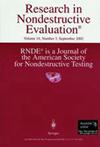基于子区域有限元法的涡流检测问题的计算研究与光滑缺陷综合
IF 1.6
4区 材料科学
Q3 MATERIALS SCIENCE, CHARACTERIZATION & TESTING
引用次数: 1
摘要
涡流检测(ECT)是检测导体裂纹和缺陷的关键技术。本研究首次探讨了子区域法作为一种有效的数学和计算技术如何与有限元法(FEM)相结合来研究电痉挛问题的多缺陷参数。在任何计算技术中,将缺陷区域从整个领域中分离出来都将节省时间和存储空间。本文给出了不同类型缺陷的例子。研究结果表明,分区域有限元法可有效地解决各种无损评价问题,缩短了90%的加工时间。本文的计算结果与传统有限元方法的结果基本一致,可用于在线和现场测试问题。通过对含缺陷铝(T6061-T6)试样的测试,验证了子区域有限元算法的正确性。利用隧道磁阻(TMR)传感器测量从法向至样品顶表面的磁场分量。实现了最小化处理时间的主要组成部分,这可能导致将该技术用于在线和现场测试问题。本文章由计算机程序翻译,如有差异,请以英文原文为准。
A computational investigation and smooth-shaped defect synthesis for eddy current testing problems using the subregion finite element method
ABSTRACT Eddy Current Testing (ECT) plays a key role in detecting cracks and defects in conductors. The present study examines for the first time how the subregion method as an effective mathematical and computational technique can be admixed with Finite Element Method (FEM) to study multiple defects parameters for ECT issues. Separating a defect region from the entire domain in any computational technique will save both time and storage space. Examples of different types of defects are presented in this article . A tangible result of processing time reduction by 90% has been achieved which has led us to consider the subregion FEM method as an effective method in solving different Nondestructive Evaluation (NDE) problems. An agreement between our results and others using classical FEM has been achieved which could lead to using this technique in online and field testing problems. The presented subregion FEM algorithm was verified experimentally with good agreement by testing Aluminum (T6061-T6) samples with defects. A Tunneling Magnetoresistive (TMR) sensor was used to measure the component of the magnetic field from normal to the sample top surface. A major component of minimizing processing time was achieved, which could lead to using this technique in online and field testing problems.
求助全文
通过发布文献求助,成功后即可免费获取论文全文。
去求助
来源期刊

Research in Nondestructive Evaluation
工程技术-材料科学:表征与测试
CiteScore
2.30
自引率
0.00%
发文量
14
审稿时长
>12 weeks
期刊介绍:
Research in Nondestructive Evaluation® is the archival research journal of the American Society for Nondestructive Testing, Inc. RNDE® contains the results of original research in all areas of nondestructive evaluation (NDE). The journal covers experimental and theoretical investigations dealing with the scientific and engineering bases of NDE, its measurement and methodology, and a wide range of applications to materials and structures that relate to the entire life cycle, from manufacture to use and retirement.
Illustrative topics include advances in the underlying science of acoustic, thermal, electrical, magnetic, optical and ionizing radiation techniques and their applications to NDE problems. These problems include the nondestructive characterization of a wide variety of material properties and their degradation in service, nonintrusive sensors for monitoring manufacturing and materials processes, new techniques and combinations of techniques for detecting and characterizing hidden discontinuities and distributed damage in materials, standardization concepts and quantitative approaches for advanced NDE techniques, and long-term continuous monitoring of structures and assemblies. Of particular interest is research which elucidates how to evaluate the effects of imperfect material condition, as quantified by nondestructive measurement, on the functional performance.
 求助内容:
求助内容: 应助结果提醒方式:
应助结果提醒方式:


